Exterminous Hypertime
Abstract
1. The Basic Theory
1.1. Two Dimensional Time
1.2. Time Travel
2. Hypercausation
2.1. Stability
Stability: For all n and m, and for some j and k: tn-Tm is qualitatively identical to tn-Tm−1 except when a time traveller from tj≥n-Tm−1 has time travelled to tk≤n-Tm.
2.2. Explaining Stability
3. Overdetermination
3.1. The Threat of Overdetermination
3.2. There Is No Problem of Overdetermination
3.3. Exterminous Hypertemporal Worlds Need Not Be Worlds of Systematic Overdetermination
Case one: Moscovium decay with no time travel. At t2021-T1 a moscovium atom has 0.5 chance of decaying a few millseconds later. And, indeed, it decays. Further, no time travel takes place at this world. At t2021-T2, consider the same atom. Since no time travel has occurred, it has a chancechc of decaying equal to 0.5. However, given Stability it must decay, so at t2021-T2 it has a chance of decaying equal to 17.
4. Hypercausal Laws
4.1. Local vs. Global
Global Effect: For any event, e, and all j, k, m and n, if e occurred at tm-Tn−1 then whether or not it occurs at hyperlater hypertimes depends upon whether a time traveller has (or has not) time travelled from tj≥m-Tn−1 to tk≤m-Tn:If a time traveller has not time travelled from tj≥m-Tn−1 to tk≤m-Tn then e occurs iff it occurred at tm-Tn−1 (except where tm-Tn−1 does not exist—i.e., where Tn is the first hypertime—in which case e has a chance of occurring equal to its chancechc of occurring).If a time traveller has time travelled from tj≥m-Tn−1 to tk≤m-Tn then e may or may not have occurred. Its occurrence will be probabilistically governed; the chance (at tl-Tn, for all l < m) of e occurring is equal to its chancechc of occurring8.
Case Two: Moscovium decay with time travel and interaction. As per Case One, but a time traveller from t3000-T1 has time travelled to T2 to an instant a few hours earlier than t2021. There, the time traveller accelerates the moscovium atom to close to the speed of light, lowering its chancechc of decaying from 0.5 to 0.1.
Case Three: Moscovium decay with time travel but no interaction. As per Case Two, but the time traveller does not interact with the moscovium atom (for instance, because they arrive on the other side of the world).
Case Four: The Andromeda case. At t2021-T1 there exists a time portal. Stepping through it, you travel to the Andromeda galaxy in 50,000 BC. Staying for a few minutes, you then use the portal to return back to the future on Earth. Obviously, what you do in Andromeda’s Palaeolithic past does not affect events on the planet Earth in its history leading up to the present day.
Local Effect: For any event e, and all m, n and k, whether an event e occurs at tm-Tn depends upon whether someone has or has not time travelled from tj≥m-Tn−1 to tk≤m-Tn:If a time traveller has not time travelled from tj≥m-Tn−1 to tk≤m-Tn then e occurs iff it occurred at tm-Tn−1 (except where tm-Tn−1 does not exist—i.e., where Tn is the first hypertime—in which case e has a chance of occurring equal to its chancechc of occurring).If some time traveller has time travelled from tj≥m-Tn−1 to tk≤m-Tn then e’s occurring or not depends upon whether some time traveller has causally interacted/influenced any factors governing e’s occurring or not. If some such factor has been influenced by a time traveller, then e’s occurring is now independent of what went on at the hyperearlier time-hypertime; e’s chance of occurring is equal to its chancechc of occurring. If some such factor has not been influenced by a time traveller (e.g., the time traveller arrived too spatiotemporally distant to influence e’s coming about or not) then e occurs iff it occurred at tm-Tn−1.
4.2. Propagative Laws
- For all j and k, tj-Tk is not hyper-resilient iff something tried to causally influence tj-Tk−1 that did not try to causally influence tj-Tk−2; otherwise, tj-Tk is hyper-resilient.
- For all j and k, if tj-Tk is hyper-resilient then events occur at it iff they occurred at tj-Tk−1. This is the case even if something (e.g., a time traveller coming from the previous hypertime) tries to causally influence them to be otherwise, i.e., hyper-resilience ‘trumps’ all other forms of causal force and activity.
- If a time-hypertime is not hyper-resilient then there is no hypercausal influence between its hyperprior time-hypertime and it. What goes on at such time-hypertimes is governed only by what went on at hypersimultaneous earlier times in combination with the causal influence of any time traveller who has arrived from the hyperprevious hypertime.
5. Applications of Global Propagation
5.1. The Multiple Time Travellers Problem
- 50,000 BC–49,990 BC include Malcolm’s arrival in the past and the changes he has made;
- 49,990 BC–1930 AD are just as they are at T1 (i.e., with no Malcolm at them, nor affected by anything Malcolm did at 49,990 BC or earlier);
- 1930 AD–1940 AD include my arrival in the past, assassinating Hitler, and preventing World War II;
- 1940 AD onwards is exactly as it originally was at T1, i.e., Hitler is alive, World War II is taking place, etc.
5.2. The Metaphysical Possibility of Time Travel Fictions
6. Hyperexpectations
6.1. Personal Hyperfutures
Case Five. Survival in a propagative world. Global Propagation is true. I am wondering whether to time travel from t2021-T1 to t1930-T2, i.e., I am wondering whether to time travel to 1930 AD. If I did, then the world would be as depicted in Figure 3. But—as Figure 3 makes clear—when I leave t2021-T1, I fail to appear at t1930-T2.
6.2. Hyperexpectations
Case Six. The Retrorifle Case. I live in a world where Global Effect is true. Rather than time travelling to 1930 in order to kill Hitler I instead fire a bullet from my ‘retrorifle’. Such a gun fires a bullet back in time from t2021-T1 to t1930-T2, shooting Hitler dead. However, I myself do not travel in time; I remain at T1.
7. Conclusions
8. Appendix: The Metaphysics of Time
8.1. Tenseless vs. Tensed Exterminous Hypertime
8.2. The Dimensionality of the A-Series
8.3. Presentist/Moving Spotlight Exterminous Hypertime
8.4. Growing Block Theory and the Open Future
Bigger growing block theory can (and, presumably, should!) accept the analogue:For all j and k: tj precedes tk iff the times that exist when tj is privileged are a subset of the times that exist when tk is privileged.
Given that analogue principle, there would then be a one-dimensional A-series like the following:For all j, k, m, and n: tm-Tn precedes tj-Tk iff the time-hypertimes that exist when tm-Tn is privileged are a subset of the time-hypertimes that exist when tj-Tk is privileged.
- (a)
- Facts about hyperearlier-and-later time-hypertimes are determinate; or
- (b)
- Facts about any later time-hypertime—whether that time-hypertime is hyperearlier, hypersimultaneous, or hyperlater—are indeterminate.
8.5. Summary
Funding
Acknowledgments
Conflicts of Interest
| 1 | Even given time travel is physically impossible, some people might think the following question was of interest: ‘If time travel were physically possible, then what model of time travel would be true?’. However, that the question is as odd as asking whether, were magic possible, would it work like it does in Harry Potter or as it does in Dungeons and Dragons? What a bizarre question that is! Similarly, unless time travel is physically possible, I doubt any sensible answer to that counterfactual question will be forthcoming. |
| 2 | Throughout this paper, I assume Progression is true. Elsewhere [2], I discuss exterminous hypertemporal worlds at which Progression is false and ‘hypertime travel’, where one can travel into the hyperpast, is possible. |
| 3 | This footnote discusses the topology of hypertime. A temporal series is discrete iff, with the exception of the first and last instants, every instant has an immediately prior instant and an immediately later instant. (Where x is immediately prior to y iff x is earlier than y and there is no z such that z is earlier than y and later than x; a similar definition applies to ‘immediately later’.) A temporal series is dense iff between any two instants there is a third instant [50] (p. 23) [51] (pp. 195–218) [52] (p. 112). Clearly, no dense series is discrete and no discrete series is dense. (Another way of thinking about it is to think of a discrete temporal series as being contiguous to the natural number series, e.g., … −1, −2, 0, 1, 2…, whilst a dense series is contiguous to, e.g., the irrational number series or real number series.) Whilst it might be technically possible to believe in both Progression and dense hypertime, the most natural interpretation is that time travellers leave one hypertime and move to the ‘next’ hypertime. Since believing that there is a ‘next’ hypertime is just to believe that hypertime is discrete, throughout this paper, I assume that hypertime is discrete. |
| 4 | Smith intends this to be a problem for Goddu’s theory of hypertime [3] (and Meiland’s [53], but I have elsewhere suggested that Meiland’s theory is not a hypertemporal theory at all [40]). Goddu does not believe hypertime is exterminous, instead believing it to be ‘conterminous’ (see also [1] (p. 76–77)). Conterminous hypertime is different from exterminous hypertime in that, at any given hypertime, only one regular time exists. Further, as time advances, hypertime advances. Two examples help clarify the difference. Where ◄ is the ‘hyperearlier than’ relation:
Given such orderings, Smith’s overdetermination worry is not a problem, although for reasons different than for the exterminous theorist. Consider the Haiti example. Exterminous hypertime has a problem because the events at one time-hypertime (i.e., t1804-T2) are overdetermined in virtue of being caused by events from two distinct time-hypertimes (e.g., from the earlier t1803-T2 as well as the hyperearlier t1804-T1). No such problem arises given conterminous hypertime. Whilst the conterminous hypertemporal theorist believes that the liberation at t1804-T1804 is caused by earlier events and caused by hyperearlier events, they are not distinct events—the causes earlier in regular time and the causes that are hyperearlier are numerically identical events! Since the events are not distinct, there is not an overdetermination challenge to begin with. |
| 5 | For discussion of the problem of systematic overdetermination being one of unlikelihood, see Funkhouser [54] (pp. 333–338). Other philosophers believe that the problem is something other than unlikelihood (see [55] for discussion); this paper ignores those alternative understandings of the problem of overdetermination. |
| 6 | Smith explicitly likens the problem of overdetermination in the hypertemporal case to the problem of overdetermination in the philosophy of mind (and, when I wrote about the problem [1] (pp. 83–84), I had a similar issue in mind). It is worth noting, then, that when it comes to the problem of overdetermination in the philosophy of mind there are already philosophers who argue against the problem for very similar reasons that I have just given [56,57] (pp. 227–228) [58] (p. 452) [59] (see also [60] and [61] (pp. 722–723)). |
| 7 | A referee raised a worry. Physics says that the half-life of moscovium-287 is 37 milliseconds, i.e., its probability of decaying during that period is 0.5. When I say that its ‘objective chance’ of decaying in that period is instead 1 and its ‘chancechc’ of decaying is 0.5, you might think I have become definitionally confused. ‘Objective chance’ picks out just that probability function which physicists are interested in, i.e., the function that says moscovium’s probability of decay is 0.5. So what I call ‘chancechc’ just is what we call ‘objective chance’; moreover, what I call ‘objective chance’ must be a totally different function—a function that we might worry is so weird and bizarre that it cannot play a serious philosophical role. The worry is misplaced. Compare to a case where we consider some quantum event which we usually believe has a chance of occurring between 0 and 1. However, imagine it turned out that the ‘hidden variable theory’ was true, whereby quantum events occur (or not) because of purely deterministic features of the world that we do not have access to. A superscientist who had access to those variables—and who could carry out the appropriate predictions—would see of every event that its chance was either 0 or 1; this would be true, even though more ignorant scientists justifiably treated those events as being genuinely stochastic. I claim that there is at least one context/interpretation/understanding whereby: (i) the superscientist is correct to say that the probability function given by the hidden variables is the ‘objective chance’ function; whilst (ii) the probability function which ignorant scientists are interested in is instrumentally useful, even if it is not the objective chance function. If you hold fixed that context/interpretation/understanding, the initial worry of this footnote goes away. A physicist in Case One who was availed of the true laws of nature will, if they suspect they are at a hyperinstant later than T1, know that all later events have an objective chance of occurring equal to either 0 or 1. However, since there is no time travel in Case One, that physicist will be ignorant of what those chances are. So she—along with her more ignorant colleagues who do not know that later events are nomically enslaved to hyperearlier events—will routinely talk about the moscovium atom having a probability of decaying other than 0 or 1. She correctly recognises that the probability function she is aiming for when she talks in this fashion (i.e., the ‘chancechc function’) is not the objective chance function, but it is nevertheless still a perspicuous function that she, and all other scientists, can and should make use of. So I do not think there is any definitional confusion in what I say in the main text. (Additionally, note that there are time-hypertimes at which the decay of the moscovium atom is a chancey affair. At t2021-T1 the objective chance of the atom decaying a few milliseconds later at T1 is 0.5. That also means that it is also true at t2021-T1 that the atom’s objective chance of decaying at t2021-T2 is 0.5. It is only later on that its chance increases to 1.) |
| 8 | In regular one-dimensional temporal worlds, the chance of an event occurring at an earlier time is always 0 or 1, for once the event has/has not happened, it is no longer a matter of chance as to whether it did/did not happen. A similar principle must be true of exterminous hypertemporal worlds—this paper assumes that the chance of events at any hyperearlier time-hypertime is equal to 0 or 1. That is: Even events that occur in your (regular) future are no longer chancey as long as they occurred in the hyperearlier hyperpast. |
| 9 | Footnote 3 argued that hypertime is discrete. Given Global Propagation, regular time must also be discrete because changes to history ripple forward at the rate of one temporal instant per hypertemporal instant, thus one series cannot be continuous whilst the other is discrete. (Discussions of discrete time include [52,62,63,64] (pp. 114–121); note that, for my purposes, time need only be possibly discrete, not actually discrete.) One option is that regular time is composed of finitely many ‘temporal atoms’. (Such temporal atomicity has been maintained by the likes of: Martinus Capella, the Buddhist Santarankitas, Abu’l–Hasan al Ash’ari, and Abu’l-Mansur al-Maturidi of Samarqand [65]; al-Ghazali and the Mutakallimun, the Greek Epicureans, the medieval philosophers Joannes Canonicus and Nicholas Bonet, and the Jewish philosopher Moses Maimonides [66] (pp. 34–35); (arguably) Descartes [67] (p. 627 n. 2); and the early Russell [68] (p. 6)). Changes to history would then take a finite number of hyperinstants to ripple forwards. For instance, if I time travel to 1930 and kill Hitler then we need only wait until, say, t2021-Tgoogol for 2021 to be such that World War II never occurred. A second option is that time is composed of an infinite, yet discrete, number of instants. In that case, I would have to wait until, say, t1930-Tω for 2021 to be such that World War II never occurred. (Thanks to Emily Thomas for help with the history of belief in temporal atomicity.) |
| 10 | I trialled a similar solution elswhere [40], but at the time I did not think it worked (for reasons spelt out in that paper). In that paper, I was considering ‘past vacillation theory’, which is quite different from exterminous hypertime. Nevertheless, the theory of hyper-resilience spelled out in Section 4.2 could probably be tweaked to work for the theory of past vacillation and allow that theory to similarly avoid the Multiple Time Travellers problem. |
| 11 | Following on from fn10, I suspect that if changes propagated through vacillating time, rather than exterminous hypertime, we probably could allow for the possibility of the narrative of ‘Timeslides’ (at least, that element of it—there are other elements of the narrative, not discussed in this paper, that might prove problematic). |
| 12 | This raises the question of what it takes for a stage from some future hypertime to be a stage of Nikk Effingham rather than someone else. I have argued elsewhere that there are no great pitfalls to be faced on this issue [1] (see also [5] (pp. 3–4) and [10] (pp. 92–107) for discussion), so I am happy to assume that the hyperfuture stages I pick out are, indeed, stages of Nikk Effingham. |
| 13 | We can rigorously define what a time and a hypertime is:
|
| 14 | Instead of a time-hypertime being privileged, we might think that a hypertime is privileged (and that all time-hypertimes at that hypertime are likewise privileged). A weirder alternative is that the present time is metaphysically privileged. I do not discuss these alternatives because they seem substantially less plausible than the view discussed in the main text. |
| 15 |
References
- Effingham, N. Time Travel: Probability and Impossibility; Oxford University Press: Oxford, UK, 2020. [Google Scholar]
- Effingham, N. The Metaphysical Possibility of Time Travel Fictions. Erkenntnis 2021, 1–21. [Google Scholar] [CrossRef]
- Goddu, G. Time Travel and Changing the Past (Or How to Kill Yourself and Live to Tell the Tale). Ratio 2003, 16, 16–32. [Google Scholar] [CrossRef]
- Goddu, G. Avoiding or Changing the Past? Pac. Philos. Q. 2011, 92, 11–17. [Google Scholar] [CrossRef]
- Goddu, G. Changing, Annulling, and Otherwising the Past. Philosophies 2021, 6, 71. [Google Scholar] [CrossRef]
- Van Inwagen, P. Changing the Past. Oxf. Stud. Metaphys. 2010, 5, 3–28. [Google Scholar]
- Wasserman, R. Paradoxes of Time Travel; Oxford University Press: Oxford, UK, 2018. [Google Scholar]
- Smith, N. Why time travellers (still) cannot change the past. Rev. Port. De Filos. 2015, 71, 677–693. [Google Scholar] [CrossRef]
- Hudson, H.; Wasserman, R. Van Inwagen on Time Travel and Changing the Past. Oxf. Stud. Metaphys. 2010, 5, 41–49. [Google Scholar]
- Hudson, H. The Fall and Hypertime; Oxford University Press: Oxford, UK, 2014. [Google Scholar]
- Lucas, J. A Century of Time. In The Arguments of Time; Butterfield, J., Ed.; Oxford University Press: Oxford, UK, 1999. [Google Scholar]
- Swinburne, R. Space and Time; Macmillan Press: London, UK, 1968. [Google Scholar]
- Forbes, G. Review of Oxford Studies in Metaphysics: Volume 5. Analysis 2010, 70, 571–577. [Google Scholar] [CrossRef][Green Version]
- Baron, S. Back to the Unchanging Past. Pac. Philos. Q. 2017, 98, 129–147. [Google Scholar] [CrossRef]
- Lewis, D. The Paradoxes of Time Travel. Am. Philos. Q. 1976, 13, 145–152. [Google Scholar]
- Smith, N. Bananas Enough for Time Travel? Br. J. Philos. Sci. 1997, 48, 363–389. [Google Scholar] [CrossRef]
- Baron, S.; Yi-Cheng, L. Time, and Time Again. Philos. Q. 2021, Forthcoming. [Google Scholar]
- Broad, C. An Examination of McTaggart’s Philosophy Vol. II; Cambridge University Press: Cambridge, UK, 1938. [Google Scholar]
- MacBeath, M. Time’s Square. In The Philosophy of Time; Le Poidevin, R., MacBeath, M., Eds.; Oxford University Press: Oxford, UK, 1993. [Google Scholar]
- Richmond, A. Plattner’s Arrow: Science and Multi-Dimensional Time. Ratio 2002, 13, 256–274. [Google Scholar] [CrossRef]
- Rutledge, J. Purgatory, Hypertime, & Temporal Experience. J. Anal. Theol. 2018, 6, 152–161. [Google Scholar]
- Schlesinger, G. Aspects of Time; Hackett Publishing Company: Cambridge, UK, 1980. [Google Scholar]
- Skow, B. Objective Becoming; Oxford University Press: Oxford, UK, 2015. [Google Scholar]
- Smart, J. The River of Time. Mind 1949, 58, 483–494. [Google Scholar] [CrossRef]
- Tan, P. The Growing Block and What was Once Present. Erkenntnis 2020, Forthcoming. [Google Scholar] [CrossRef]
- Thomson, J. Time, Space, and Objects. Mind 1965, 74, 1–27. [Google Scholar] [CrossRef]
- Wilkerson, T. Time and Time Again. Philosophy 1973, 48, 173–177. [Google Scholar] [CrossRef]
- Wilkerson, T. More Time and Time Again. Philosophy 1979, 54, 110–112. [Google Scholar] [CrossRef]
- Bars, I. Survey of Two-Time Physics. Class. Quantum Gravity 2001, 18, 3113. [Google Scholar] [CrossRef]
- Bars, I. Twistor Superstring in Two-Time Physics. Phys. Rev. D 2004, 70, 104022. [Google Scholar] [CrossRef]
- Bars, I. Gravity in Two-Time Physics. Phys. Rev. D 2008, 77, 125027. [Google Scholar] [CrossRef]
- Bars, I.; Deliduman, C. High Spin Gauge Fields and Two-Time Physics. Phys. Rev. D 2001, 64, 045004. [Google Scholar] [CrossRef]
- Bars, I.; Kuo, Y. Supersymmetric Field Theory in Two-Time Physics. Phys. Rev. D 2007, 76, 105028. [Google Scholar] [CrossRef]
- Craig, W.; Weinstein, S. On Determinism and Well-posedness in Multiple Time Dimensions. Proc. R. Soc. A 2009, 465, 3023–3046. [Google Scholar] [CrossRef]
- Vafa, C. Evidence for F-Theory. Nucl. Phys. B 1996, 469, 403–415. [Google Scholar] [CrossRef]
- Effingham, N. An Unwelcome Consequence of the Multiverse Thesis. Synthese 2012, 184, 375–386. [Google Scholar] [CrossRef]
- Colyvan, M.; Garfield, J.; Priest, G. Problems with the Argument from Fine-tuning. Synthese 2005, 145, 325–338. [Google Scholar] [CrossRef][Green Version]
- Hawthorne, J.; Isaacs, Y. Misapprehensions about the Fine-tuning Argument. R. Inst. Philos. Suppl. 2017, 81, 133–155. [Google Scholar] [CrossRef]
- McGrew, T.; McGrew, L.; Vestrup, E. Probabilities and the Fine-tuning Argument: A Sceptical View. Mind 2001, 110, 1027–1038. [Google Scholar] [CrossRef]
- Effingham, N. Vacillating Time: A Metaphysics for Time Travel and Geachianism. Synthese 2021, Forthcoming. [Google Scholar]
- Baxter, S. Timelike Infinity; HarperCollins: London, UK, 1992. [Google Scholar]
- Millar, M.; Murphy, S. Chrononauts; Image Comics: Portland, OR, USA, 2015. [Google Scholar]
- Sawyer, R. On the Surface. In Future Wars; Greenberg, M., Segriff, L., Eds.; DAW: New York, NY, USA, 2003. [Google Scholar]
- Berman, R.; Braga, B. Star Trek: Enterprise; Paramount Network Television: Los Angeles, CA, USA, 2001–2005. [Google Scholar]
- Naylor, G. Red Dwarf; British Broadcasting Corporation (BBC): London, UK, 1988. [Google Scholar]
- Tooley, M. Time, Tense, and Causation; Oxford University Press: Oxford, UK, 1997. [Google Scholar]
- Miller, K. Presentism, Eternalism, and the Growing Block. In A Companion to the Philosophy of Time; Dyke, H., Bardon, A., Eds.; Wiley Blackwell: London, UK, 2013. [Google Scholar]
- Briggs, R.; Forbes, G. The Real Truth about the Unreal Future. Oxf. Stud. Metaphys. 2012, 7, 257–301. [Google Scholar]
- Longenecker, M. Future Ontology: Indeterminate Existence or Non-existence. Philosophia 2020, 48, 1493–1500. [Google Scholar] [CrossRef]
- Brown, R. Elements of Modern Topology; McGaw-Hill: London, UK, 1968. [Google Scholar]
- Nerlich, G. The Shape of Space, 2nd ed.; Cambridge University Press: Cambridge, UK, 1994. [Google Scholar]
- Newton-Smith, W. The Structure of Time; Routledge: London, UK, 1980. [Google Scholar]
- Meiland, J. A Two-dimensional Passage Model of Time for Time Travel. Philos. Stud. 1974, 26, 153–173. [Google Scholar] [CrossRef]
- Funkhouser, E. Three Varieties of Overdetermination. Pac. Philos. Q. 2002, 83, 335–351. [Google Scholar] [CrossRef]
- Engelhardt, J. What is the Exclusion Problem? Pac. Philos. Q. 2015, 96, 205–232. [Google Scholar] [CrossRef]
- Kroedel, T. Dualist Mental Causation and the Exclusion Problem. Noûs 2015, 49, 357–375. [Google Scholar] [CrossRef]
- Loewer, B. Mental Causation, or Something Near Enough. In Meaning, Mind, and Matter: Philosophical Essays; Lepore, E., Loewer, B., Eds.; Oxford University Press: Oxford, UK, 2011. [Google Scholar]
- Lowe, E. Substance Dualism: A Non-Cartesian Approach. In The Waning of Materialism; Bealer, G., Koons, R.C., Eds.; Oxford University Press: Oxford, UK, 2010. [Google Scholar]
- White, B. Metaphysical Necessity Dualism. Synthese 2018, 195, 1779–1798. [Google Scholar] [CrossRef]
- Bernstein, S. Overdetermination Undetermined. Erkenntnis 2016, 81, 17–40. [Google Scholar] [CrossRef]
- Sider, T. What’s So Bad About Overdetermination? Philos. Phenomenol. Res. 2003, 67, 719–726. [Google Scholar] [CrossRef]
- Ardourel, V. A Discrete Solution for the Paradox of Achilles and the Tortoise. Synthese 2015, 192, 2843–2861. [Google Scholar] [CrossRef]
- Forrest, P. Is Space-Time Discrete or Continuous? An Empirical Question. Synthese 1995, 103, 327–354. [Google Scholar] [CrossRef]
- Van Bendegem, J. In Defence of Discrete Space and Time. Log. Et Anal. 1995, 150–152, 127–150. [Google Scholar]
- Jammer, M. Concepts of Time in Physics: A Synopsis. Phys. Perspect. 2007, 9, 266–280. [Google Scholar] [CrossRef]
- Turetzky, P. Time; Routledge: London, UK, 1998. [Google Scholar]
- Levy, K. Is Descartes a Temporal Atomist? Br. J. Hist. Philos. 2005, 13, 627–674. [Google Scholar] [CrossRef]
- Hager, P. Russell and Zeno’s Arrow Paradox. Russell J. Bertrand Russell Stud. 1987, 7, 3–10. [Google Scholar] [CrossRef][Green Version]
- Groening, M. Futurama; 20th Century Fox: Los Angeles, CA, USA, 1999–2013. [Google Scholar]
- Loss, R. How to Change the Past in One-Dimensional Time. Pac. Philos. Q. 2015, 96, 1–11. [Google Scholar] [CrossRef]
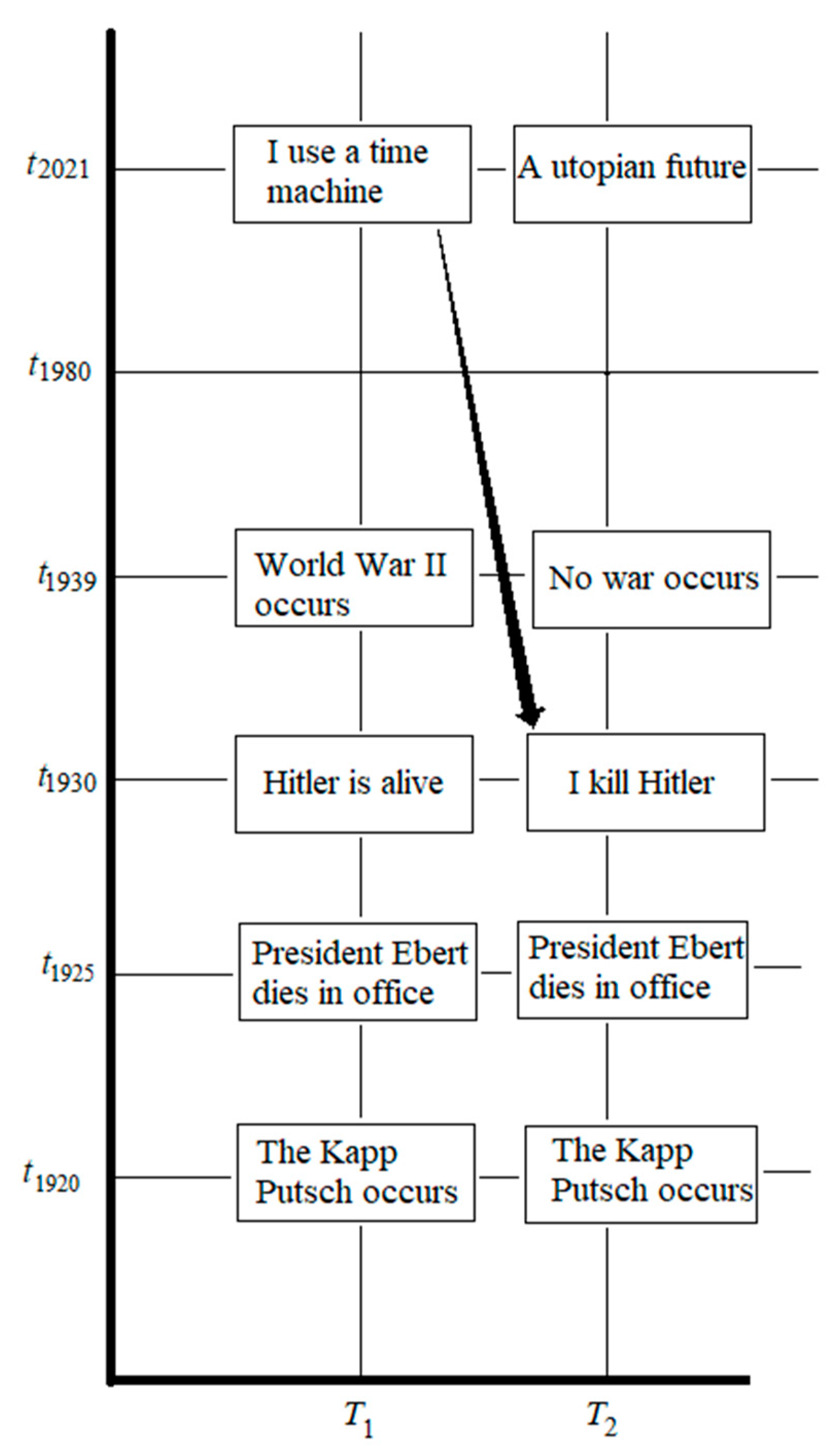
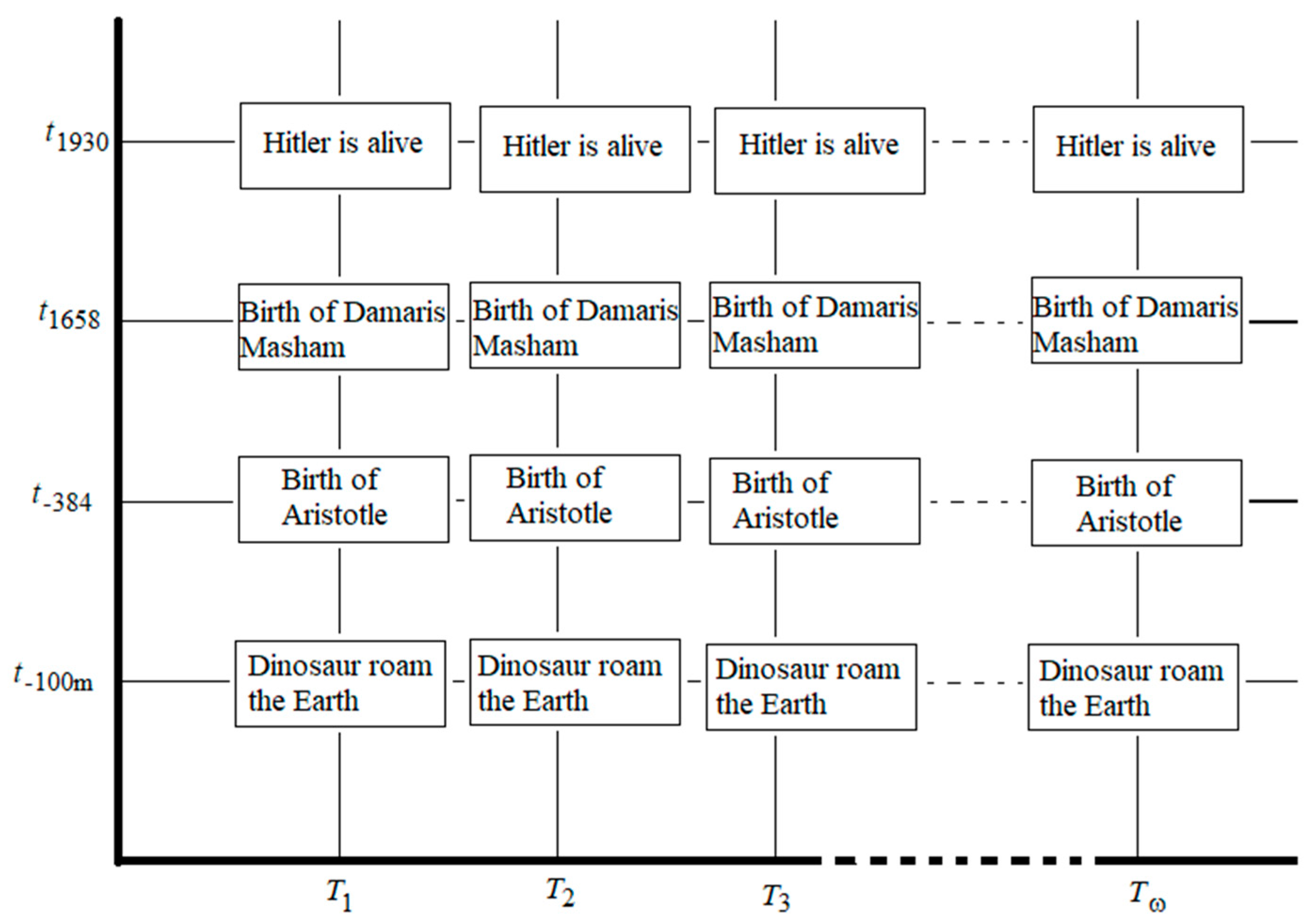
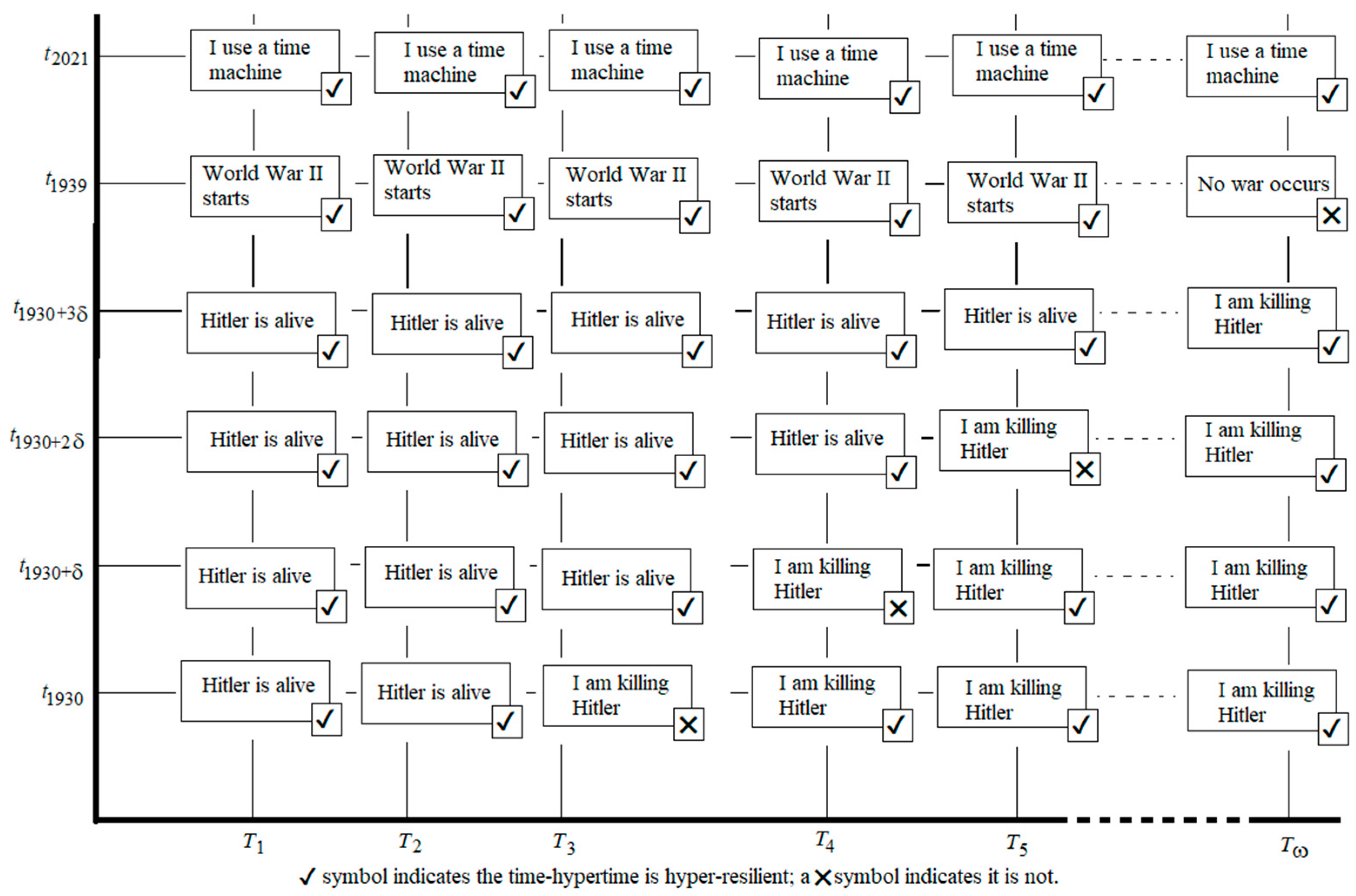
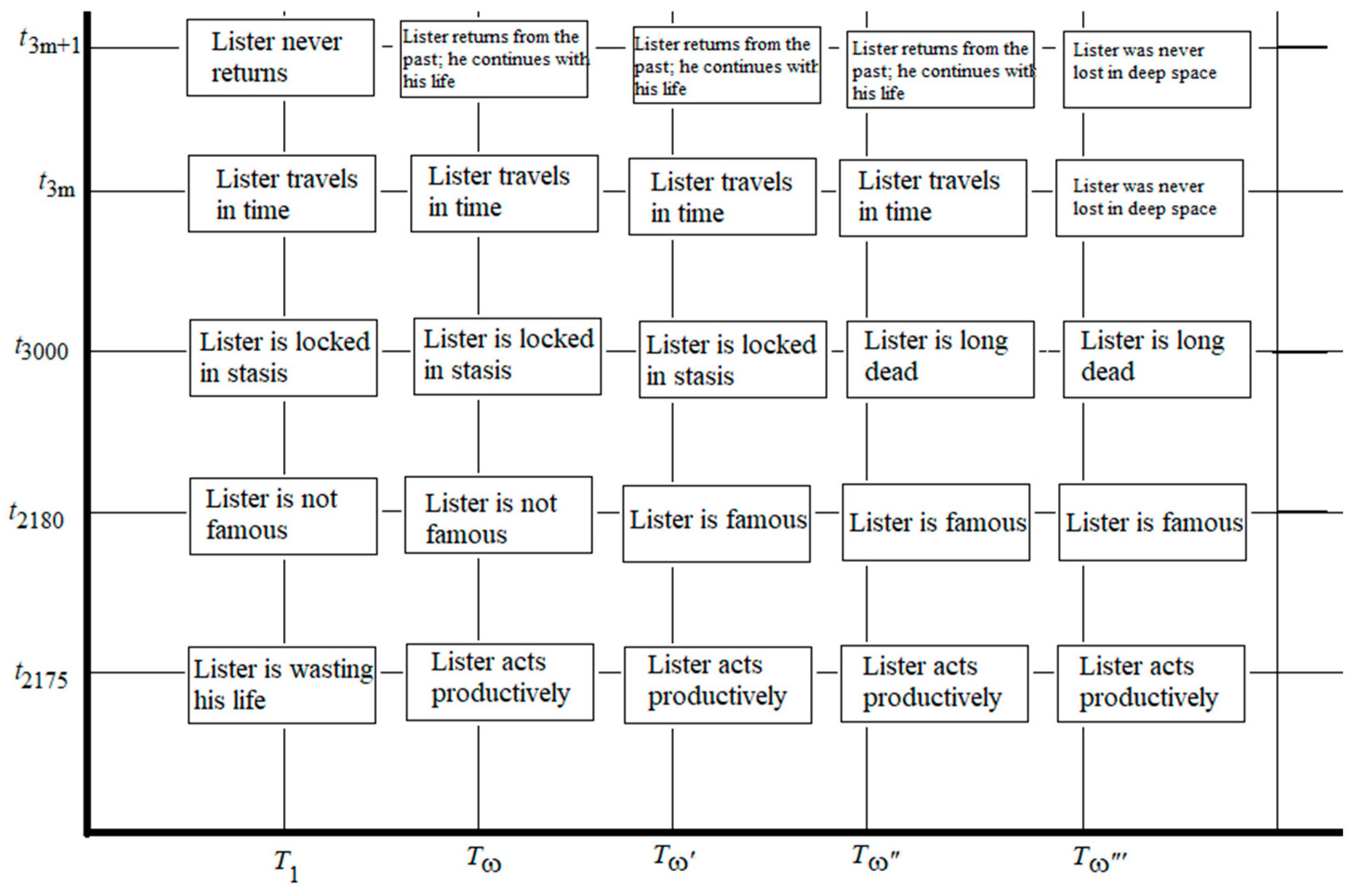
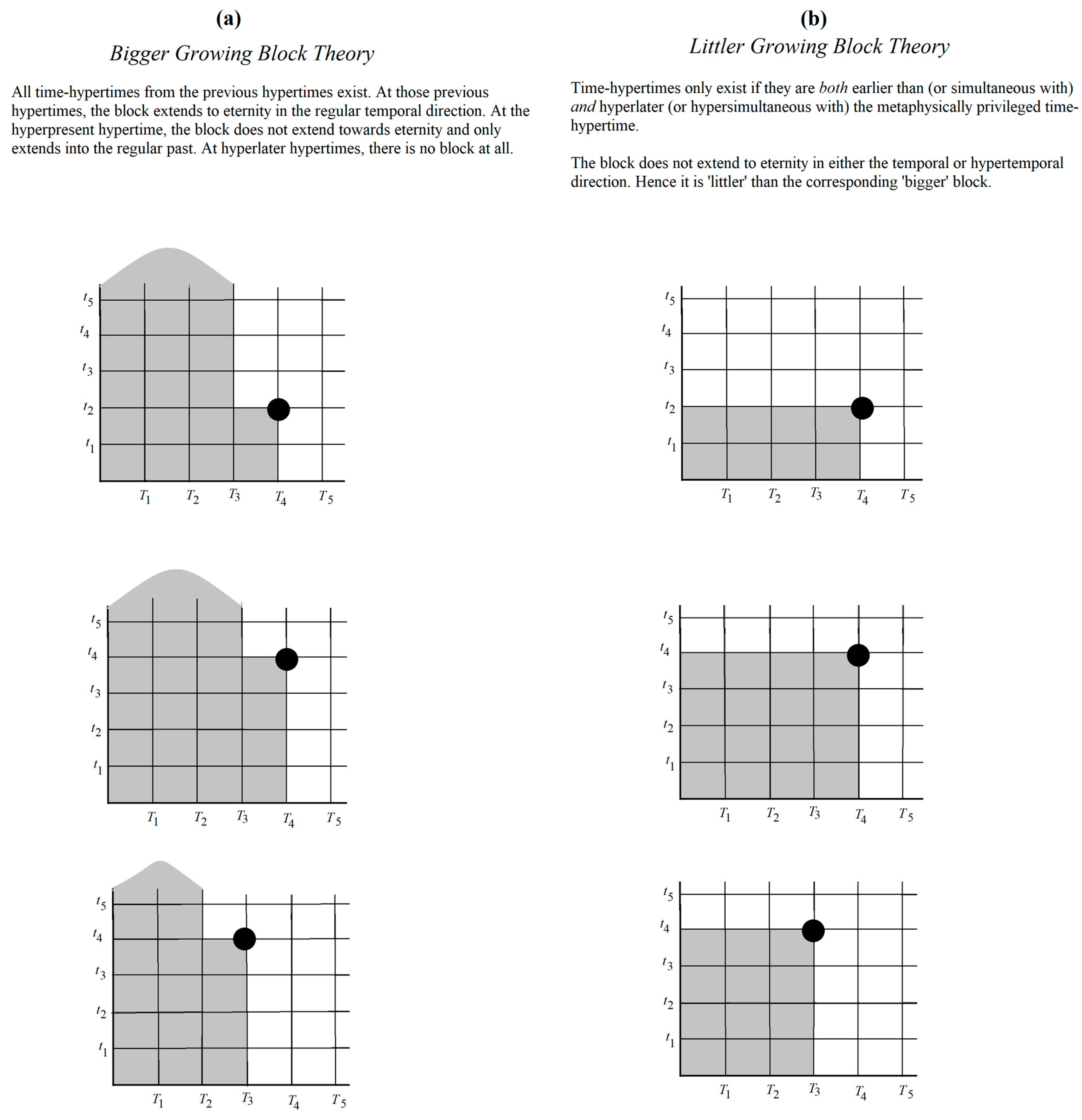
Publisher’s Note: MDPI stays neutral with regard to jurisdictional claims in published maps and institutional affiliations. |
© 2021 by the author. Licensee MDPI, Basel, Switzerland. This article is an open access article distributed under the terms and conditions of the Creative Commons Attribution (CC BY) license (https://creativecommons.org/licenses/by/4.0/).
Share and Cite
Effingham, N. Exterminous Hypertime. Philosophies 2021, 6, 85. https://doi.org/10.3390/philosophies6040085
Effingham N. Exterminous Hypertime. Philosophies. 2021; 6(4):85. https://doi.org/10.3390/philosophies6040085
Chicago/Turabian StyleEffingham, Nikk. 2021. "Exterminous Hypertime" Philosophies 6, no. 4: 85. https://doi.org/10.3390/philosophies6040085
APA StyleEffingham, N. (2021). Exterminous Hypertime. Philosophies, 6(4), 85. https://doi.org/10.3390/philosophies6040085




